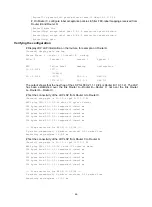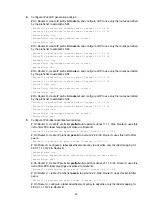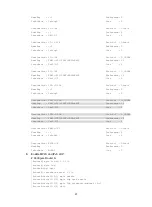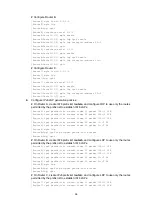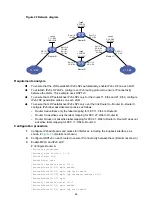
55
IPv6 LDP configuration examples
IPv6 LDP LSP configuration example
Network requirements
Router A, Router B, and Router C all support MPLS.
Configure LDP to establish IPv6 LSPs between Router A and Router C, so subnets 11::0/64 and
21::0/64 can reach each other over MPLS.
Configure LDP to establish LSPs only for destinations 100::1/128, 100::2/128, 100::3/128, 11::0/64,
and 21::0/64 on Router A, Router B, and Router C.
Figure 22 Network diagram
Requirements analysis
•
To ensure that the LSRs establish IPv6 LSPs automatically, enable IPv6 LDP on each LSR.
•
To establish IPv6 LDP LSPs, configure an IPv6 routing protocol to ensure IP connectivity
between the LSRs. This example uses OSPFv3.
•
To control the number of IPv6 LSPs, configure an IPv6 LSP generation policy on each LSR.
Configuration procedure
1.
Configure IPv6 addresses and masks for interfaces, including the loopback interfaces, as
shown in
. (Details not shown.)
2.
Configure OSPFv3 on each router to ensure IP connectivity between them:
# Configure Router A.
<RouterA> system-view
[RouterA] ospfv3
[RouterA-ospfv3-1] router-id 1.1.1.9
[RouterA-ospfv3-1] area 0
[RouterA-ospfv3-1-area-0.0.0.0] quit
[RouterA-ospfv3-1] quit
[RouterA] interface loopback 0
[RouterA-LoopBack0] ospfv3 1 area 0.0.0.0
[RouterA-LoopBack0] quit
[RouterA] interface gigabitethernet 1/1/1
[RouterA-GigabitEthernet1/1/1] ospfv3 1 area 0.0.0.0
[RouterA-GigabitEthernet1/1/1] quit
[RouterA] interface serial 1/1/0
Router A
Router B
Router C
Loop0
1.1.1.9/32
100::1/128
Loop0
2.2.2.9/32
100::2/128
Loop0
3.3.3.9/32
100::3/128
Ser1/1/0
10::1/64
Ser1/1/1
20::1/64
Ser1/1/0
10::2/64
Ser1/1/0
20::2/64
11::0/64
21::0/64
GE1/1/1
11::1/64
GE1/1/1
21::1/64






